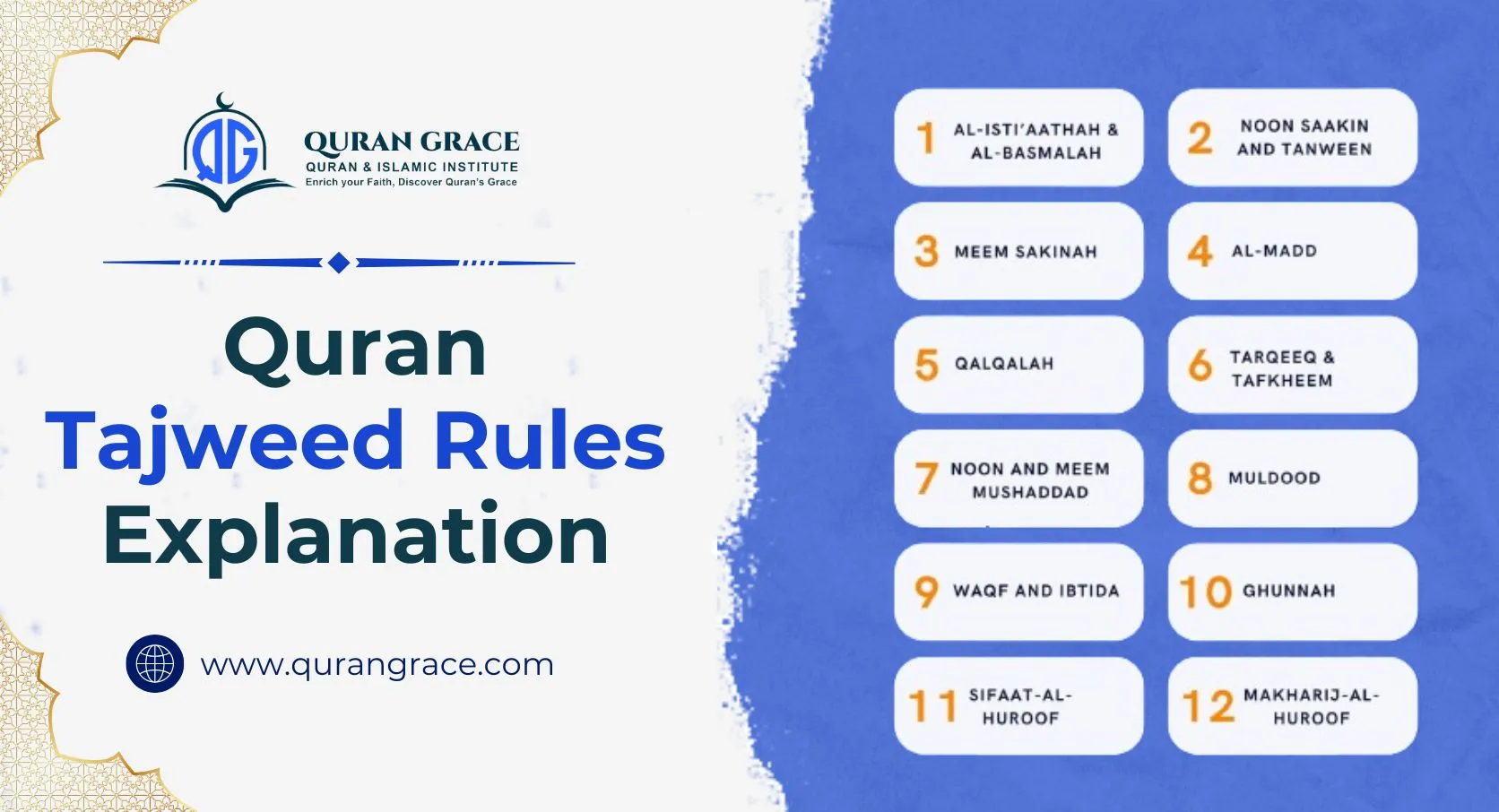The Holy Quran has a unique way of being read, and learning Tajweed is considered one of the most honourable disciplines within Islamic jurisprudence. Quran Grace is dedicated to teaching Tajweed to its students properly and effectively and making them capable of reciting the Quran the same as natives.
Our aim in teaching Tajweed is to help pronounce the words of the Quran accurately, avoid mistakes during recitation, and strengthen the connection with verses. To guide readers, we have listed various rules of Tajweed to recite the Quran beautifully and correctly. In the tajweed course Muslims can learn all the rules of leading the quran properly.
12 Rules of Tajweed in the Quran
Several rules of Tajweed are mandatory to learn to avoid grave mistakes in recitation. Here is a list of the top 12 rules of Tajweed.
- Al-Isti’aathah & Al-Basmalah
- Qalqalah
- Noon Saakin and Tanween
- Mim Sakinah
- Heavy and light letters (Tafkhim and Tarqiq)
- Madd (Elongation)
- Ghunnah
- Noon and Meem Mushaddad
- Muldood
- Waqf and Ibtida
- Sifaat al-Huroof
- Makharij Al-Huroof
1. Al-Isti’aathah & Al-Basmalah
Al-Isti’aathah الاستعاذة, also known as “seeking refuge,” involves reciting “A’udhu billahi min ash-shaytan ir-rajim” before beginning to recite the Quran. It simply means seeking Allah’s protection from the devil. Before engaging with the sacred text, reciting Al-Isti’aathah allows you to seek refuge and assistance from Allah.
Al-Basmalah البسملة comprises the phrase “Bismillah al-Rahman al-Rahim,” translating to “In the name of Allah, the Most Gracious, the Most Merciful.” It is recited at the onset of most chapters (Surahs) of the Quran.
There are 6 Rules of Al-Isti’aathah and Al-Basmalah
- Reciting Al-Isti’aathah once suffices for the entire Quran, although it’s recommended to recite it at the beginning of each surah.
- Commence every surah with “In the name of Allah” (Basmalah), except for Surah Al-Tawbah.
- Within a surah, including Basmalah is optional but encouraged; it enriches your connection to the text.
- At the commencement of a surah, you can combine “seeking refuge” with Basmalah.
- Between two surahs, Basmalah can either be joined with the previous surah or omitted, but it should not be both.
- Surah Al-Tawbah does not begin with Basmalah; reciting “Seeking Refuge” suffices.
2. Qalqalah
If any of the letters of Qalqalah appear with sukoon, it will be read with an echoing sound, whether it be in the middle of a word or at the end.
Letters of Qalqalah: ق, ط, ب, ج, د and they are collected in the sentence;
The Ulema have categorized Qalqalah into three parts:
- Heavy qalqalah: If the qalqalah letter has a Shaddah, it will be pronounced with a stronger echo.
- Medium qalqalah: If the letter of Qalqalah comes at the end of a word and you stop on it, it will be pronounced with a medium echoing sound.
- Light qalqalah: If the qalqalah letter is saakin and comes in the middle, it will be pronounced with a light echoing sound.
3. Noon Saakin and Tanween
These rules involve the pronunciation of the “noon saakin” (نْ – a “nun” with a sukoon) and “tanween” (double vowels that produce an “n” sound at the end of a word). There are four ways to pronounce these based on the letter that follows: clear (Izhar), merging (Idgham), changing (Iqlab), and concealment (Ikhfa).
- Idgham
This rule applies when noon saakin and tanween are followed by one of the Arabic letters ي ، ر،. م، ل، و، ن In this case, the noon saakin or tanween is merged or assimilated into the next letter, with no separate pronunciation.
Idgham has two types:
- With Ghunna (nasal sound): It occurs when noon saakin or tanween is followed by ي ، ن، م ، و
Examples: (وَمَن يَعْمَلْ)، (أَمَنَةً نُّعَاسًا) (مِن والٍ)
- Without Ghunna: It occurs when noon saakin or tanween is followed by ر، ل
Examples: (مِّن لَّبَنٍ)، (غَفُورٌ رَّحِيمٌ)
- Iqlab
This rule occurs when a noon saakin or tanween is followed by a ba letter (ب). The noon sakin or tanween is changed into a “mim” sound (م) due to the influence of the following ba letter.
Example of Iqlab rule
واللهُ سَمِيعٌ بَصِيرٌ turns into والله سميعمبصير
- Ikhfaa
When this rule is applied to the noon saakinah or tanween, the articulation point (makhraj) shifts to a position similar to the hidden letter. As a result, the reciter moves the tip of his tongue slightly away from the gums of the upper teeth.
This rule is applied when noon saakin or tanween is followed by one of the Ikhfaa letters (ص، ذ، ث، ك، ج، ش، ق، س، د، ط، ز، ف، ت، ض، ظ).
Examples of Ikhfaa rules
وَأَمَّا عَادٌ فَـأُهْلِكُوا بِرِيحٍ صَرْصَرٍ
- Izhar
The Izhar rule occurs when a noon sakin or tanween is followed by any letter from the “Izhar ” letters category ء ، ه، ع،غ، ح، خ In this case, the noon sakin or tanween is pronounced clearly without any nasal sound.
Examples of Izhar rule
(تنحتون) ، (من حكيم)
4. Mim Sakinah
Similar to Nun Sakinah and Tanween, the rules of Mim Sakinah focus on the pronunciation of the “mim” with a sukoon (م). These rules include clear pronunciation (Izhar Shafawi), merging (Idgham Shafawi), and concealment (Ikhfa Shafawi).
5. Heavy and light letters (Tafkhim and Tarqiq)
Tajweed differentiates between heavy and light letters, which influence the quality of recitation. Heavy letters are articulated with a full mouth, while light letters are pronounced otherwise.
The letters of Tafkheem, also known as the heavy letters, are referred to as the letters of Isti’laa, which means “the letters that rise high.” When pronouncing these letters, the tongue is elevated, creating a space between the bottom of the tongue and the roof of the mouth (the soft palate). This elevation allows for reverberation and a heavier sound to occur. There are only 7 heavy letters in the Arabic language:
- Taa – ط
- Daad – ض
- Saad – ص
- Dhaa – ظ
- Qaaf – ق
- Ghayn – غ
- Khaa – خ
Tarqeeq refers to the thinning of letters, where the mouth does not produce any echo or reverberation. The lighter letters are known as the letters of ‘Istifal,’ which means ‘falling.’ These Istifal letters allow the tongue to rest at the bottom of the mouth without any observable echo. The rest of the letters other than the heavy ones are the letters of tarqeeq.
6. Madd (Elongation)
This rule governs the extension of vowel sounds under certain conditions, enhancing the melodic flow of Quranic recitation. It can be of two types:
- Al-Madd al-Asli (the original/natural elongation): this type occurs when a consonant sound is followed by a long vowel.
- Al-madd al-far’iee (the secondary elongation): this type occurs when a vowel sound is prolonged due to hamzah.
7. Ghunnah
Ghunnah is a Tajweed rule that introduces a nasal sound when specific Arabic letters are followed by certain nasal letters. This rule ensures accurate pronunciation and contributes to the melodious recitation of the Quran.
Essential details regarding Ghunna letters:
Meem (م) and Noon (ن) are known as Ghunna letters because they have a Shaddah that causes a nasal sound to be created.
When these letters are stressed with Shaddah, the sound of Ghunna is prolonged by two harakat (two beats).
Even if the Meem or Noon does not have a Shaddah, ghunna still happens when other Tajweed rules like Idgham, Ikhfa, and Iqlab are applied.
8. Noon and Meem Mushaddad:
Noon and Meem Mushaddad are Tajweed rules governing the pronunciation of certain Arabic letters when accompanied by a Shaddah (ّ), a diacritical mark indicating the doubling of the consonant’s sound.
When a Noon (ن) carries a Shaddah, it is pronounced with a prolonged nasal sound, similar to the English “nn” in “unnecessary.” For example, in the word “مُنَّافِقُونَ” (hypocrites) in Surah Al-Baqarah (2:8), the Noon with Shaddah is elongated, emphasizing the doubled nasal sound and distinguishing it from a regular Noon.
Similarly, Meem (م) with a Shaddah undergoes an elongated pronunciation, producing a prolonged nasal sound akin to the English “mm” in “hammer.” For instance, in the word “سَمَّاءٌ” (sky) found in Surah Al-Mulk (67:3), the Meem with Shaddah is elongated, highlighting the doubled nasal pronunciation.
9. Muldood
Muldood refers to the elongation of specific vowels in Arabic pronunciation, particularly Alif (ا), Ya (ي), and Waw (و). This elongation is denoted by a written symbol called Maddah placed over the respective letter.
Example of Muldood from the Quran, In Surah Al-Muzzammil (73:4) Allah commands the Prophet Muhammad (peace be upon him), saying, “أَوْ زِدْ عَلَيْهِ وَرَتِّلِ الْقُرْآنَ تَرْتِيلًا” (Or add to it, and recite the Quran with measured recitation). In the word “تَرْتِيلًا” (with measured recitation), the Ya (ي) is elongated (Muldood) with a Maddah symbol (ٓ) placed above it.
10. Waqf and Ibtida (pause and start)
Waqf and Ibtida’ are important Tajweed rules that govern the pauses and starts when reciting the Quran. Waqf rules involves knowing when to pause at specific points within the Quranic text, while Ibtida’ dictates where to begin recitation.
Example of Waqf and Ibtida from the Quran, In Surah Al-Fatiha (1:1-2), the beginning of the Quran, the phrase “بِسْمِ اللَّهِ الرَّحْمَٰنِ الرَّحِيمِ” (In the name of Allah, the Most Gracious, the Most Merciful) marks the Ibtida’ (starting point) of the chapter. After reciting the phrase that points at the beginning of a new chapter with the name of Allah, the Most Merciful, the Most Compassionate, it is customary to perform a brief waqf—a deliberate pause that invites reflection. But why is this practice so essential?
11. Sifaat-al-Huroof
Sifaat al Huroof is an important rule of Tajweed that reveals the intricate characteristics of each letter in the Arabic language. Each letter is more than just a symbol; it carries specific attributes that dramatically influence how it sounds. For instance, consider the concepts of heaviness (tafkheem) and lightness (tarqeeq). These qualities not only affect pronunciation but also enrich the beauty and rhythm of spoken Arabic. Additionally, elongation (madd) plays a crucial role in extending sounds for clarity and emphasis.
Example of Sifaat-al-Huroof from the Quran, In Surah Al-Baqarah (2:197), Allah instructs regarding the Hajj pilgrimage, saying, “وَأَذِّنْ فِي النَّاسِ بِالْحَجِّ” (And announce to the people the Hajj [pilgrimage]; they will come to you on foot and every lean camel; they will come from every distant pass.) Here, the letter “ق” (Qaf) in “الْحَجِّ” is pronounced with Tafkheem (emphasis), emphasizing the significance of the Hajj pilgrimage.
Two Types of Sifaat-Al-Huroof
- Sifaat Mutadaaddah (Continuous Attributes)
Sifaat Mutadaaddah refers to the characteristics of letters that allow for the continuous flow of breath when pronounced. Remembered with the phrase “فحثه شخص سكت,” these ten letters, known as whisperers, facilitate smooth and uninterrupted pronunciation without causing a break in the breath. Examples include فَ (fa), حَ (ha), and شَ (sheen).
- Sifaat Ghayr Mutadaaddah (Discontinuous Attributes)
Sifaat Ghayr Mutadaaddah involves letters where the breath is discontinued during pronunciation, characterised by a clear vibration of the vocal cords. The quality of jahr, or loudness, is found in the remaining 19 letters, known as majhoorah, including ع (ain), ظ (dha), and غ (ghain).
12. Makharij-al-Huroof
Makharij al-Huroof, often translated as the “points of articulation,” is a crucial rule/concept in Tajweed. These points denote the specific places where Arabic letters originate in the mouth and throat.
A thorough understanding of Makharij al-Huroof is essential for accurate Quranic recitation, as each letter’s pronunciation is determined by its point of origin.
Example of Makharij-al-Huroof from the Quran, In various Quranic verses, we can find examples illustrating Makharij al-Huroof. For instance, consider the word “قلب” (qalb), meaning heart, mentioned in Surah Al-Baqarah (2:7). The letter “ق” originates from the back of the throat, while “ل” (lam) is articulated from the tip of the tongue. This distinction in the point of articulation affects the pronunciation of each letter.
Another example can be observed in Surah Al-Falaq (113:5), where Allah says, “قُلْ أَعُوذُ بِرَبِّ الْفَلَقِ” (Say, “I seek refuge in the Lord of Daybreak”). The letter “ق” (Qaf) in the word “الْفَلَقِ” originates from Al-Jawf, the hollow of the throat. Proper pronunciation of Qaf from this area is crucial for maintaining the integrity of the recitation.
Conclusion
Tajweed is a profound discipline that enriches the Quran recitation experience by connecting more deeply to Allah’s words. It is a journey of continuous learning and improvement, offering spiritual rewards and the satisfaction of preserving the Quran. As Muslims, committing to learning Tajweed is a way to honour the Quran and its place in our lives, ensuring its correct recitation and understanding for generations.








